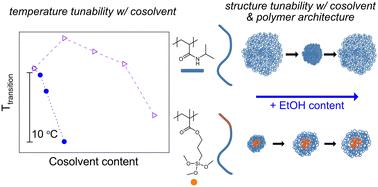当前位置:
X-MOL 学术
›
Soft Matter
›
论文详情
Our official English website, www.x-mol.net, welcomes your feedback! (Note: you will need to create a separate account there.)
Cosolvent incorporation modulates the thermal and structural response of PNIPAM/silyl methacrylate copolymers
Soft Matter ( IF 3.4 ) Pub Date : 2024-03-21 , DOI: 10.1039/d4sm00246f Jason D. Linn 1 , Fabian A. Rodriguez 2 , Michelle A. Calabrese 1
Soft Matter ( IF 3.4 ) Pub Date : 2024-03-21 , DOI: 10.1039/d4sm00246f Jason D. Linn 1 , Fabian A. Rodriguez 2 , Michelle A. Calabrese 1
Affiliation

|
Polymers functionalized with inorganic silane groups have been used in wide-ranging applications due to the silane reactivity, which enables formation of covalently-crosslinked polymeric structures. Utilizing stimuli-responsive polymers in these hybrid systems can lead to smart and tunable behavior for sensing, drug delivery, and optical coatings. Previously, the thermoresponsive polymer poly(N-isopropyl acrylamide) (PNIPAM) functionalized with 3-(trimethoxysilyl)propyl methacrylate (TMA) demonstrated unique aqueous self-assembly and optical responses following temperature elevation. Here, we investigate how cosolvent addition, particularly ethanol and N,N-dimethyl formamide (DMF), impacts these transition temperatures, optical clouding, and structure formation in NIPAM/TMA copolymers. Versus purely aqueous systems, these solvent mixtures can introduce additional phase transitions and can alter the two-phase region boundaries based on temperature and solvent composition. Interestingly, TMA incorporation strongly alters phase boundaries in the water-rich regime for DMF-containing systems but not for ethanol-containing systems. Cosolvent species and content also alter the aggregation and assembly of NIPAM/TMA copolymers, but these effects depend on polymer architecture. For example, localizing the TMA towards one chain end in ‘blocky’ domains leads to formation of uniform micelles with narrow dispersities above the cloud point for certain solvent compositions. In contrast, polydisperse aggregates form in random copolymer and PNIPAM homopolymer solutions – the size of which depends on solvent composition. The resulting optical responses and thermoreversibility also depend strongly on cosolvent content and copolymer architecture. Cosolvent incorporation thus increases the versatility of inorganic-functionalized responsive polymers for diverse applications by providing a simple way to tune the structure size and optical response.
中文翻译:

共溶剂的掺入可调节 PNIPAM/甲基丙烯酸甲硅烷酯共聚物的热响应和结构响应
由于硅烷反应性,用无机硅烷基团官能化的聚合物已被广泛应用,这使得能够形成共价交联的聚合物结构。在这些混合系统中使用刺激响应聚合物可以为传感、药物输送和光学涂层带来智能且可调节的行为。此前,用甲基丙烯酸3-(三甲氧基甲硅烷基)丙酯(TMA)功能化的热响应聚合物聚( N-异丙基丙烯酰胺)(PNIPAM)在温度升高后表现出独特的水性自组装和光学响应。在这里,我们研究了共溶剂的添加,特别是乙醇和N , N-二甲基甲酰胺 (DMF),如何影响 NIPAM/TMA 共聚物中的转变温度、光学混浊和结构形成。与纯水性系统相比,这些溶剂混合物可以引入额外的相变,并且可以根据温度和溶剂组成改变两相区域边界。有趣的是,TMA 的掺入强烈改变了含 DMF 体系的富水状态的相界,但对含乙醇体系没有影响。共溶剂种类和含量也会改变 NIPAM/TMA 共聚物的聚集和组装,但这些影响取决于聚合物结构。例如,对于某些溶剂组合物,将TMA定位于“块状”域中的一个链端会导致形成在浊点以上具有窄分散性的均匀胶束。相比之下,多分散聚集体在无规共聚物和 PNIPAM 均聚物溶液中形成 - 其大小取决于溶剂成分。由此产生的光学响应和热可逆性也很大程度上取决于共溶剂含量和共聚物结构。因此,共溶剂的引入提供了一种调节结构尺寸和光学响应的简单方法,从而增加了无机官能化响应聚合物在不同应用中的多功能性。
更新日期:2024-03-21
中文翻译:

共溶剂的掺入可调节 PNIPAM/甲基丙烯酸甲硅烷酯共聚物的热响应和结构响应
由于硅烷反应性,用无机硅烷基团官能化的聚合物已被广泛应用,这使得能够形成共价交联的聚合物结构。在这些混合系统中使用刺激响应聚合物可以为传感、药物输送和光学涂层带来智能且可调节的行为。此前,用甲基丙烯酸3-(三甲氧基甲硅烷基)丙酯(TMA)功能化的热响应聚合物聚( N-异丙基丙烯酰胺)(PNIPAM)在温度升高后表现出独特的水性自组装和光学响应。在这里,我们研究了共溶剂的添加,特别是乙醇和N , N-二甲基甲酰胺 (DMF),如何影响 NIPAM/TMA 共聚物中的转变温度、光学混浊和结构形成。与纯水性系统相比,这些溶剂混合物可以引入额外的相变,并且可以根据温度和溶剂组成改变两相区域边界。有趣的是,TMA 的掺入强烈改变了含 DMF 体系的富水状态的相界,但对含乙醇体系没有影响。共溶剂种类和含量也会改变 NIPAM/TMA 共聚物的聚集和组装,但这些影响取决于聚合物结构。例如,对于某些溶剂组合物,将TMA定位于“块状”域中的一个链端会导致形成在浊点以上具有窄分散性的均匀胶束。相比之下,多分散聚集体在无规共聚物和 PNIPAM 均聚物溶液中形成 - 其大小取决于溶剂成分。由此产生的光学响应和热可逆性也很大程度上取决于共溶剂含量和共聚物结构。因此,共溶剂的引入提供了一种调节结构尺寸和光学响应的简单方法,从而增加了无机官能化响应聚合物在不同应用中的多功能性。



























 京公网安备 11010802027423号
京公网安备 11010802027423号